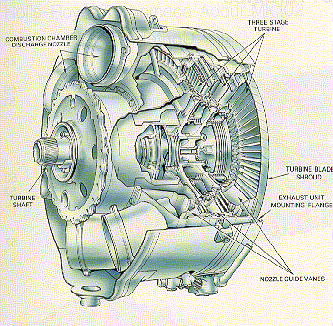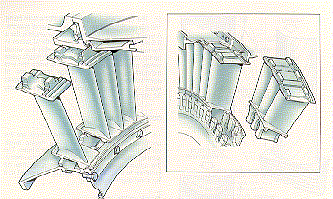 Back to the Purdue AAE Propulsion main page.
Back to the Purdue AAE Propulsion main page.
 Back to the Turbine Engine Basics page.
Back to the Turbine Engine Basics page.
 Back to the Purdue AAE Propulsion main page.
Back to the Purdue AAE Propulsion main page.
 Back to the Turbine Engine Basics page.
Back to the Turbine Engine Basics page.
 A turbine works like a compressor in reverse. Static nozzles convert pressure
to velocity, and a moving section converts that velocity to rotational
motion. Again, there are two types, both centrifugal and axial, but axial
turbines are far more common.
A turbine works like a compressor in reverse. Static nozzles convert pressure
to velocity, and a moving section converts that velocity to rotational
motion. Again, there are two types, both centrifugal and axial, but axial
turbines are far more common.
Considerations in the design of the blades is different, however. Because the
turbine is removing pressure instead of adding it, there is a favorable
pressure gradient. Thus, much more extreme angles are possible without flow
separation, and therfore a turbine generally has far fewer stages than a
 compressor. However, stress on the blades is much higher, due to the more
extreme angles and due to the heat of the flow. The buckets must also be
able, at these conditions, to withstand the forces of rotation. Indeed,
turbine blade design is currently one of the limiting factors on engine design.
Buckets must be periodically replaced because they stretch under centrifugal
force, a phenomenon known as "creep". Newer methods of casting, including
dirctionally solidified and single crystal castings, are used to lessen
these problems.
compressor. However, stress on the blades is much higher, due to the more
extreme angles and due to the heat of the flow. The buckets must also be
able, at these conditions, to withstand the forces of rotation. Indeed,
turbine blade design is currently one of the limiting factors on engine design.
Buckets must be periodically replaced because they stretch under centrifugal
force, a phenomenon known as "creep". Newer methods of casting, including
dirctionally solidified and single crystal castings, are used to lessen
these problems.
 Back to the Purdue AAE Propulsion main page.
Back to the Purdue AAE Propulsion main page.
 Back to the Turbine Engine Basics page.
Back to the Turbine Engine Basics page.